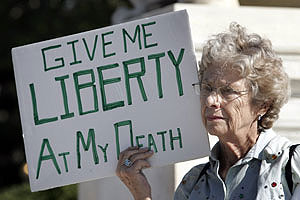The Right to Die movement, launched in 1976, has its foundation in two court decisions. In re Quinlan, the New Jersey Supreme Court ruled unanimously to appoint Karen Ann QuinlanÔÇÖs father her legal guardian with the authority to make medical decisions on her behalf, including the removal of life-sustaining treatment. With this decision, competent persons or their legal guardians obtained the legal right to refuse medical treatment. Ten years later, in Cruzan v. Director, Missouri Dept. of Health, the U.S. Supreme Court clarified that a legal guardian could request removal of life support by providing ÔÇ£clear and convincing evidenceÔÇØ of its necessity. The Terri Schiavo case, involving multiple court cases, motions, and appeals between 1990 and 2005, set no new legal standards for the Right to Die movement and affirmed decisions set out in Quinlan and Cruzan.
A contemporary offshoot of the legally established Right to Die movement is the Death with Dignity movement, calling for state policies allowing a terminally ill, medically competent adult to request and receive prescription medication to hasten death. Three states have such policies (Oregon, 1994 and 1997), Washington (2008), and Vermont (2013). The Montana Supreme Court determined there was no state law banning the prescribing of medications to hasten death for terminally ill individuals, effectively validating the practice in 2009. Montana state law also bars prosecution of doctors who help terminally ill patients end their lives. The Oregon Death with Dignity Act is considered model legislation by the movement, and a careful reading of 15 years of data published by the Oregon Health Authority demonstrates its legitimacy as a state policy.
Proponents of the Right to Die and the Death with Dignity movements argue for the principles of self-determination and autonomy. They believe an individual, acting alone or through a legal guardian, has a right to choose what happens to his or her body.
 Supporters argue one hallmark of an ethical society is the option of a compassionate and dignified end to suffering.
Supporters argue one hallmark of an ethical society is the option of a compassionate and dignified end to suffering.
Much of the opposition to the Right to Die and Death with Dignity movements arises out of religious beliefs, particularly those rooted in the tenet of the sanctity of life. Such arguments assert the practice is akin to suicide, positing an ethical society should not condone suicide in any situation. Secularly based arguments question the legitimacy of the policy, arguing risks of coercion on vulnerable populations. Some physician opponents, including organized medicine, suggest it is antithetical to a physicianÔÇÖs role as healer to end life.
The Supreme Court has ceded policy decisions about the right to die to the states. While declining to recognize a constitutional right to assisted dying, the Court has held that state laws allowing physician-assisted dying trump the U.S. Attorney GeneralÔÇÖs power to regulate controlled substances. In 2012, a slim majority of Massachusetts voters rejected a ballot question that would have legalized physician assisted dying after an aggressive campaign by the Roman Catholic Church.
Public opinion about hastened dying has been tracked by both the Harris and Gallup polling firms. A 2011 Harris Poll reported strong national support for Death with Dignity, with 70% of respondents indicating agreement with the following statement: ÔÇ£Individuals who are terminally ill, in great pain, and who have no chance for recovery, have the right to choose to end their own life.ÔÇØ A minority (17%) opposed the statement, 8% were not sure, and 4% declined to answer the question. More recently, Gallup explored the issue in relationship to the use of the word ÔÇ£suicideÔÇØ in polling questions. This poll found majority support, concluding, ÔÇ£Americans generally favor allowing doctors to assist terminally ill patients in ending their lives, but the degree of support ranges from 51% to 70%, depending on how the process is described.ÔÇØ
POLICY RECOMMENDATION: Religious arguments made against the Right to Die and Death with Dignity are personal beliefs and should not set public policy for all Americans.




